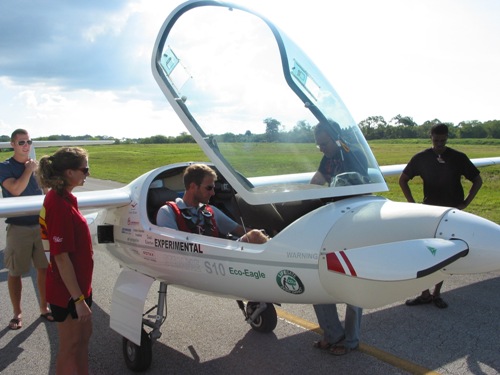New Propulsion Design Challenges Current Efficiencies of Light Airplanes

At 4:30 p.m., Sept. 7, a team of students from Embry-Riddle Aeronautical University demonstrated a first in aviation history. At that moment, in the skies over Daytona Beach, Fla., test pilot Mikhael Ponso transitioned the Eco Eagle, a hybrid propulsion aircraft they designed, from gas power to full-electric power.
Ponso reported that when he switched the Eco Eagle from gas power to electric power, the airplane's efficiency increased and its noise fell to all but silent, with the only sound a low whir of pulleys and propeller.
"This aircraft challenges the current efficiencies of light airplanes," said Pat Anderson, professor of aerospace engineering at Embry-Riddle and the team's faculty advisor. "With this technology-breaking propulsion system, Embry-Riddle's student designers are demonstrating that airplanes can be green, too."
In their technology demonstrator, the Embry-Riddle students incorporated an efficient gas motor with an electric propulsion system powered by batteries. This allows the airplane to climb on the more powerful 100-horsepower gas motor. When it reaches a cruising altitude, the airplane transitions seamlessly to a full-electric mode with 40 horsepower for the rest of the flight.
While all-electric airplanes may be the future of aviation, today's technology is still too heavy for most airplanes. The Embry-Riddle students believe their hybrid propulsion system yields the best combination of speed, climb rate, range, and endurance for currently available technology.
Over the past year and a half, around 200 students from different academic disciplines completely designed, manufactured, and tested the airplane's propulsion system. They were supervised by faculty and staff and led by Lori Costello, a graduate student in aerospace engineering.
"A hard-core group of 40 students came in after classes and jobs and worked many long hours," Costello said.
"It is unusual for university students in the United States to design, manufacture, and test a manned aircraft technology demonstrator," Anderson said. "Not only have these students designed and flown a completely new propulsion system, they are contributing to the greening of aviation. It will challenge the status quo for aircraft performance."
The Embry-Riddle team has set its sights on demonstrating the aircraft at NASA's Green Flight Challenge, Sept. 25-Oct. 3, and at other aircraft performance expos.
Funding for the project came from generous contributions by the Aviation Education Foundation and its founder James Ray; Randy Fiorenza, an Embry-Riddle alumnus; David Robertson, an Embry-Riddle trustee; Rotax Aircraft Engines; Flight Designs; MT-Propeller; Drivetek ag, Lockwood Aviation; Stemme Aircraft; and Moonshine Aviation.